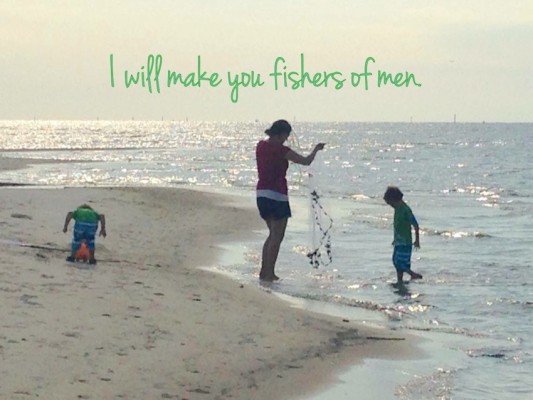“Christos Anesti ek nekron, thanato thanaton patisas, kai tis en tis mnimasi zoin harisamenos,” my little grandsons chanted in unison as I watched happily in surprised silence. “Christ is risen from the dead, trampling down death by death, and to those in the tombs, granting life,” the boys rang out in Greek, singing the ancient paschal troparion taught to them by my son-in-law, Grayson. Five-year-old James looked entranced, while two-year-old John-Henry danced around the room, slapping his hips and throwing his hands into the air to provide dramatic effect at just the right moments. Even baby Joseph, who just turned one, chimed in.
“Catholicism is caught, not taught,” I thought as I observed the children singing, remembering the familiar adage from Catholic theology that I’ve quoted numerous times to my students. “We don’t sit a one-week-old infant down and tell him everything he’ll ever need to know about the Catholic faith,” I’ve explained repeatedly when teaching how the truths of our faith are passed down intact from one generation to the next. Instead, we start with songs, pictures and simple blessings. We take the kids to Mass, point out statues and stained glass windows, and maybe light a candle for those we love. We read Bible stories, whisper prayers in the dark when bad dreams invade the night, and sing—in Greek if we so desire—the deep mysteries of our faith, learned on an iPhone while riding in the van. That’s how our children catch the faith, and it’s how we, in turn, catch it back from them.
Catholicism has been “caught” for two thousand years the very same way; that is, through the habits of a living Church that hands on its living faith via time-honored practices that grow organically and culturally throughout history. We call these practices “traditions,” and they are meant to embody and express Sacred Tradition--which is the Truth that Jesus deposited into the Church through His life, death and resurrection, and through the relationships and institutions He established.
The concept of living faith comes down to us from our Jewish ancestors, and was embraced by the Christian Church:
“Take to heart these words which I command you today. Keep repeating them to your children. Recite them when you are at home and when you are away, when you lie down and when you get up. Bind them on your arm as a sign and let them be as a pendant on your forehead. Write them on the doorposts of your houses and on your gates” (Deuteronomy 6:4-9).
In other words, we are to let our faith in God permeate everything we think and say and do. Which doesn’t mean that we’re on our knees 24/7, or that we escape our broken human condition. It does mean, however, that we invite God into all things, and that we remember that He is with us always.
Part of the crisis we are facing in our Christian culture is the direct result of the dichotomy that exists between faith and life, due in large part to a modern world that compartmentalizes and hyper-specializes every aspect of life. Our lives have become neatly divided into measurable functions and categories, reducing the expression of Christian faith to a perfunctory Sunday visit. But it is not meant to be so. Our fathers in faith reminded us that the “split between the faith which many profess and (our) daily lives deserves to be counted among the more serious errors of our age.”* They went on to tell us that harmony should exist between our faith in Christ and all of our earthly activities.
I heard that harmony Monday night in the voices of little children, as they chanted, “Christ is risen from the dead” during a family vacation. Yes indeed, they are catching the faith. And they’re throwing it back to me.
*Par. 43, Pastoral Constitution on the Church in the Modern World, Second Vatican Council
Copyright 2015 Judy Klein.
Photo copyright 2015 Judy Klein. All rights reserved.
About the Author
Judy Klein
Judy Landrieu Klein is an author, theologian and inspirational speaker whose first book, Miracle Man, chronicles her late husband Bernie's near death experience and miraculous deathbed conversion. Her new book, Mary's Way: The Power of Entrusting Your Child to God, is a CatholicMom.com imprint book published by Ave Maria Press. Judy shares her insights about the spiritual life at her blog, Holy Hope, at MemorareMinistries.com.



.png?width=1806&height=731&name=CatholicMom_hcfm_logo1_pos_871c_2728c%20(002).png)
Comments